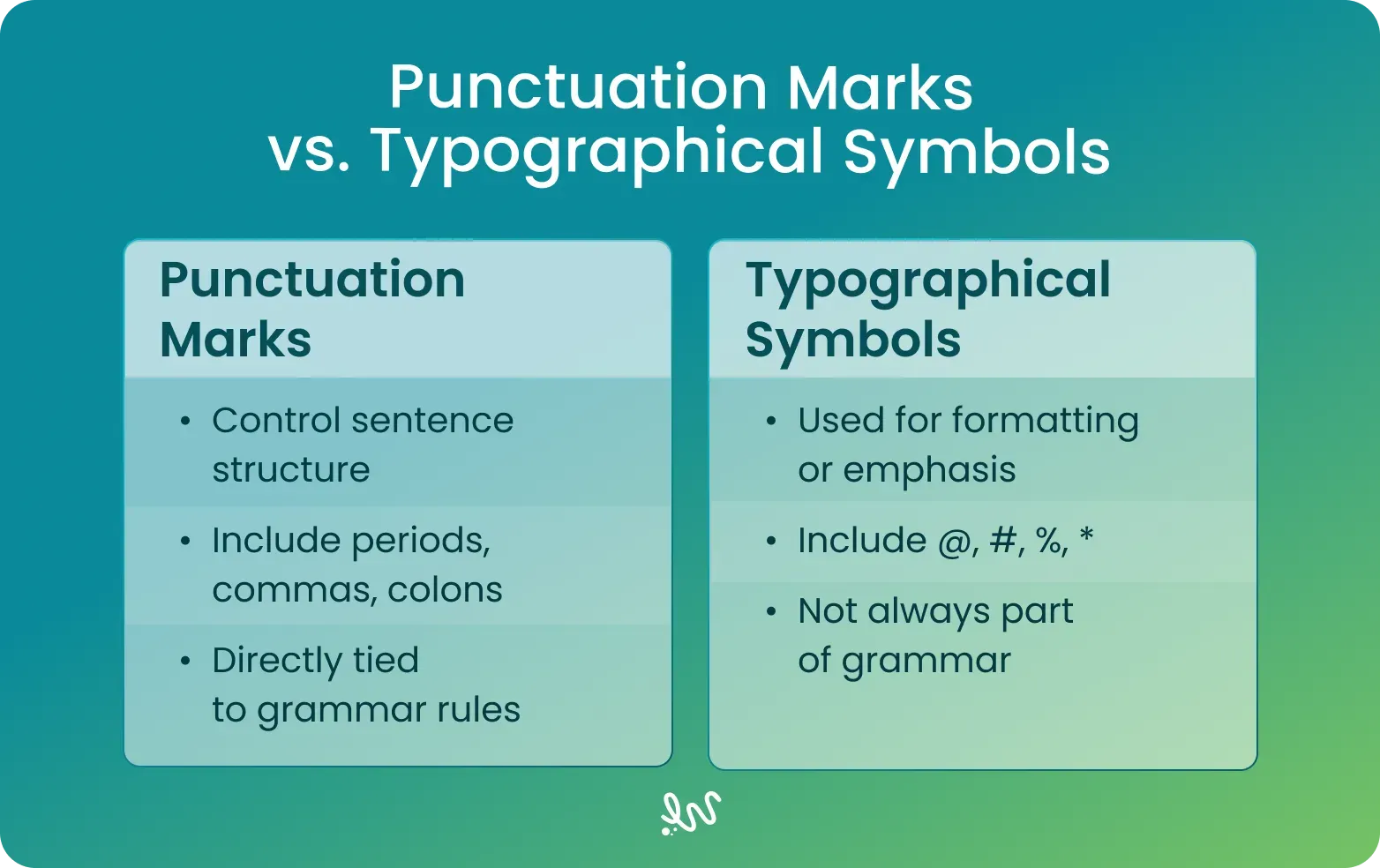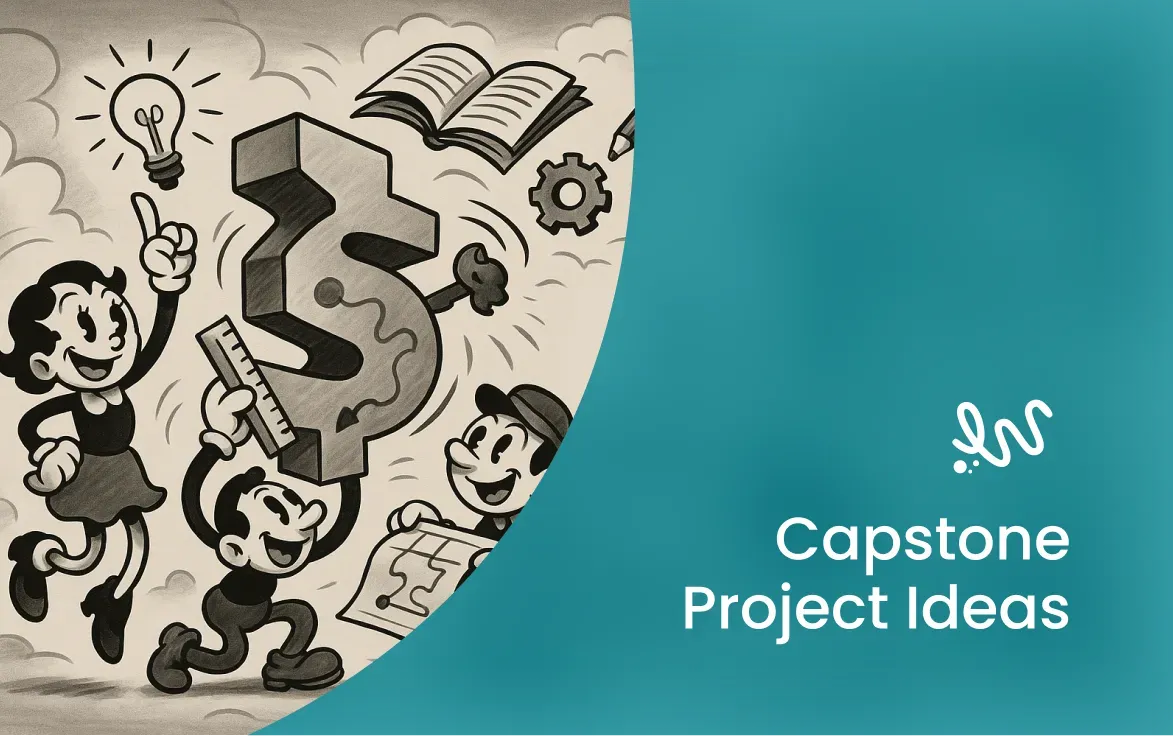You've probably seen them your whole life: periods, commas, question marks. Maybe even an em dash or ellipsis here and there. But when it's time to actually use them, things get weird fast. Do you put the comma before 'and'? Is that semicolon necessary, or are you just trying to sound smarter? Most people were never really taught how punctuation works. Not clearly, anyway.
This article walks you through the types of punctuation marks with objective, clear examples.
And if you're stuck on your writing or just want a second set of eyes, WriteMyEssay is a solid place to get help.
Punctuation Confusing You?
Make your writing clear, clean, and confident with WriteMyEssay.
Get Writing Help
What Is a Punctuation Mark?
Punctuation marks are symbols that clarify your writing. They show where your thoughts begin and end, and how the parts of a sentence relate. You probably don't think about them when they're used correctly, but the whole situation feels different if you don't have them.
Imagine reading this without punctuation:
My dog ran away he came back two hours later soaking wet we gave him a bath now he's asleep on the couch he smells like shampoo but still looks guilty
You need maximum brain power to understand this sentence. You might get a general idea, but you don't know where to stop and pause. If you have an informative essay due and want to make sure you sound grammatically correct, read our blog on how to write an informative essay.
Punctuation Marks Examples
Have you ever read a sentence and felt like something's off? Not wrong exactly, just off. That's usually punctuation. Different punctuation marks don't get much credit. They sit quietly between words, acting like traffic signals for your brain. Most people never notice them until one's missing.
This section is where you stop second-guessing commas and finally get what the semicolon is doing there in the first place.
Period (.)
A period signals the end of a sentence and completes a thought. You use it when the thought is complete. It doesn't matter how long the sentence is or when the idea is over. It also shows up in abbreviations such as Dr., a.m., etc.
Examples:
- I'm done.
- That's enough.
- She left.
Comma (,)
The comma separates parts of a sentence, signals a pause, or lists items. They break things up so your reader gets the chance to pause. But don't throw them around just because a sentence looks long.
Examples:
- She cooked pasta, lit a candle, and waited.
- After dinner, he disappeared without saying a word.
- I like books, not small talk.
Question Mark (?)
A question mark appears at the end of a sentence, shifting the tone into a question. It tilts the sentence upward and makes the reader lean in, even when the answer doesn't matter.
Examples:
- What time is it?
- Did you really eat the last slice?
- Why would anyone do that?
Exclamation Point (!)
Use the exclamation point to show strong emotion or emphasis. Don't overuse it, especially in formal writing. One exclamation point is plenty. More than that, your writing starts to look desperate.
Examples:
- Run!
- I can't believe you said that!
- This is the best thing I've ever tasted!
Colon ( : )
Colon introduces something, like a list, a detail, or an explanation. It needs a complete sentence before it. If the lead-in wouldn't stand alone, don't use a colon in there.
Examples:
- I brought everything: sunscreen, snacks, and bug spray.
- He had one rule: no phones at dinner.
- Her answer was simple: no.
Semicolon ( ; )
A semicolon joins two sentences that could stand alone, but are better together. It's stronger than a comma but not as final as a period.
Examples:
- The storm passed; the silence felt heavier than the thunder.
- She wanted to go; no one tried to stop her.
Quotation Marks ("")
Quotation marks frame speech, ideas, or titles of short things. Don't overthink it. Just keep them balanced. Punctuation usually stays inside the closing mark.
Examples:
- He said, "I'm not doing this again."
- "Have you read 'The Yellow Wallpaper'?"
- She whispered, "This feels like a mistake."
Apostrophe (')
The apostrophe shows possession or replaces letters in contractions. Its vs. it's causes confusion, but its use is usually straightforward. Just remember: 'it's' means it is.
Examples:
- That's Alex's notebook.
- I can't go.
- It's not what it looks like.
Parentheses ( )
Parentheses hold side information that doesn't need to be front and center. This information isn't essential to the sentence.
Examples:
- We saw the movie (the original version, not the remake).
- I paid for lunch (again).
Brackets [ ]
Brackets are used while quoting someone and needing to explain or insert something. These are most common in academic or edited writing.
Example:
- "She [the nurse] said he was stable."
Hyphen (-)
The hyphen connects words or breaks them when needed. It doesn't replace a dash. The difference between these two is that a hyphen links and a dash separates.
Examples:
- A well-known chef
- This is a high-risk move.
- We need long-term planning.
Dash (–)
The dash creates a break, a moment of pause, or tension. It changes the tone significantly. If a comma feels too light and a period feels too final, the dash is the perfect choice.
Examples:
- I didn't plan it – it just happened.
- She kept the letter – unopened, unread.
Ellipsis (…)
An ellipsis shows that something is left unsaid and sometimes suggests a pause. Don't use it unless the sentence calls for it. Otherwise, you will sound unsure.
Examples:
- I thought I knew what to say, but…
- "Well… maybe."
Slash (/)
The slash is used when offering two alternatives or shortening something. You'll come across the slashes in technical or informal writing. Don't use them in formal writing unless there's no cleaner way to say it.
Examples:
- Bring your passport and/or ID.
- Our next meeting is on 5/14.
- He/she will decide.
What Is a Typographical Symbol?
A typographical symbol is a visual element in writing or print that is not a number or letter. Punctuation (dot, comma, semi-colon), mathematical signs (+,=/), currency signs ($£¥), and other typographical elements (asterisk (*), ampersand (&), percent sign(%)) are categorized as typographical symbols, and are visually organized like words. Typographical symbols add effect and organize meaning visually.
Difference Between Punctuation Marks and Typographical Symbols
All punctuation marks are symbols, but not all symbols are punctuation. Punctuation helps understanding meaning; typographical symbols cover a wide range. Although they don't exactly shape grammar, they still show up everywhere.

While the difference may seem small, it matters, especially in how you format your college essay correctly, or anything academically written, for that matter. Understanding what punctuation means and what a typographical symbol represents will help make your writing look clear, readable, and easy to understand, not just filled with random marks.
Typographical Symbols Examples
You've seen them on keyboards. You've used them in passwords, in texts, on forms, but most people don't really know what half of these symbols are called, let alone what they're meant to do. Typographical symbols aren't just random decorations. They have actual uses, some technical, some stylistic, and some that sneak into academic writing more than you'd expect.
This section breaks down some of the most common typographical symbols with real examples. So next time you type one, you'll know what you're actually doing.
Asterisk (*)
The asterisk usually means "note this" or "look down for more info." You'll see it in footnotes, corrections, or when someone wants to add something at the bottom of a page.
Examples:
- This method is widely used in biology.
*See appendix B for the full data chart.
- It also pops up in informal writing as a way to correct yourself:
I definitely didn't eat five cookies.
*four
- In math, it means multiplication:
5 * 3 = 15
Ampersand (&)
This one means "and." It's more stylish than useful in most writing, but you'll see it in brand names, logos, or creative titles.
Examples:
- Johnson & Johnson
- War & Peace
- R&D stands for research & development.
Avoid it in formal essays unless it's part of a proper name.
At Sign (@)
Originally used in accounting, now it's best known for emails and social handles.
Examples:
- Send your questions to info@writemyessay.com
- Follow us @WriteMyEssay
You might also see it used in pricing (3 shirts @ $15 each) or tagging someone in online comments.
Pound or Number Sign (#)
It means "number" in traditional writing. On social media, it became a famous hashtag.
Examples:
- Apartment #4
- #FinalsWeek
Again, skip it in academic writing unless it's part of a data label.
Percent Sign (%)
Used to show percentages. Always place it after the number, with no space in between.
Examples:
- Only 25% of students submitted early.
- He improved his score by 18%.
In writing, spell it out when starting a sentence:
- Twenty percent of the class missed the deadline.
Dollar Sign ($)
Used with numbers to show money. In writing, it's clear and direct, just don't use it in formal sentences without the number.
Examples:
- The book costs $12.
- They raised $1,000 for charity.
Don't write "dollars" and "$" together. It's one or the other.
Common Mistakes in Punctuation Marks
The use of punctuation confuses us more than we care to admit. And it's not because we don't know how to use punctuation; it's because writing is quick, and those tiny marks get missed. Here are some examples of mistakes that happen all the time:
- Throwing commas in just to break up a long sentence
- Skipping the comma after words like however or for example
- Mixing up its and it's (it happens, don't worry)
- Forgetting to close quotation marks
- Putting semicolons where they don't belong
- Ending a sentence but missing the period
- Using three exclamation points to sound excited!!!
- Hitting the spacebar twice after a period (you only need one)
When you're writing an essay in a hurry, it's easy to let these slide. But if you catch them early, your writing will look way clearer.

The Bottom Line
We'll keep it simple and remind you of what matters most:
- Punctuation gives your writing structure, and it's how ideas stay clear
- We mainly use 14 punctuation marks, each serving different purposes
- Typographical symbols include more than just punctuation (like %, @, or &)
- Most mistakes come from rushing or guessing
If grammar isn't your strongest suit, we're here to help you write your essay with meaningful content and correct punctuation.
FAQ
What Does a Punctuation Mark Look Like?
A punctuation mark is anything that helps organize and clarify your writing. It's a symbol like a period, comma, question mark, etc.
Is a Comma a Punctuation Mark?
Yes, a comma is a punctuation mark that breaks down long sentences into small parts and makes it easier to follow the idea.



